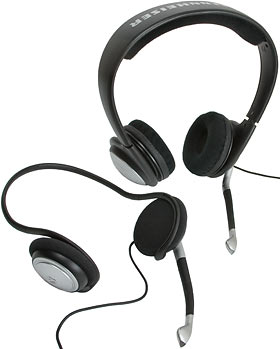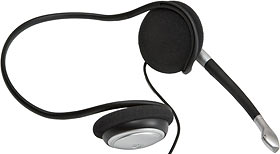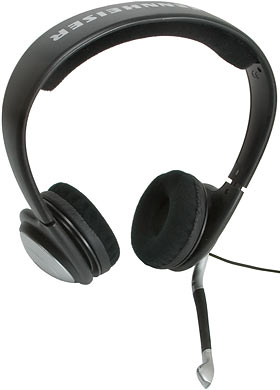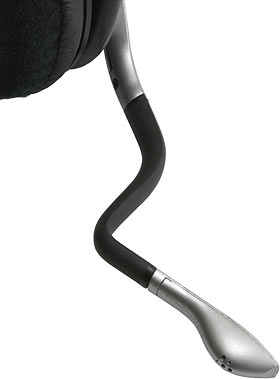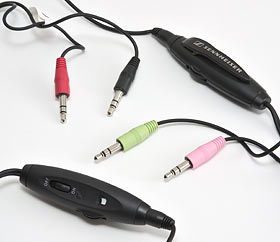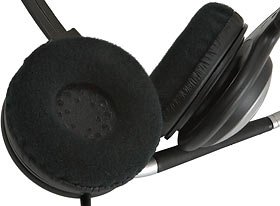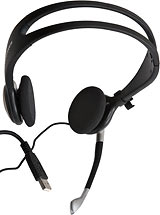
Sennheiser PC 140 and PC 150 headsets
Review date: 25 June 2004. Last modified 03-Dec-2011.
Headsets - headphones with a boom microphone - are, as I've mentioned before, easy enough to find, and usually quite nasty. It seems to be generally assumed that people who need a headset do not also need decent audio quality.
If all you're using a headset for is Internet telephony or some similar application where the limiting factor for sound quality is very unlikely to be the input and output transducers, this is fair enough. You might still like to shop around to find a headset that doesn't feel like a piece of "apparatus", but pretty much anything will do.
If you'd like a headset that doesn't sound dreadful, though...
...then you might like one of these.
Sennheiser Communications is Communications Officer of the giant German headphone company, so it's not unreasonable to expect better-than-awful sound quality from their products. That's how it turned out when I reviewed the PC-135 USB, but that headset's an oddity; most people don't need a USB audio adapter at all, much less one that roughly doubles the price of the headset.
These two headsets only offer conventional analogue connections.
The contenders
This is the PC 140 headset. It's got a "neckband", not a headband; to wear it, you loop the band around behind your head and hook the curved arms over the tops of your ears.
Here in Australia, Aus PC Market sell the PC 140 for $AU121, including delivery.
This is the PC 150. It's a conventional headband design, and Aus PC Market sell it here for $AU154, again including delivery.
Both headsets use the same bendy boom mic as the PC 135. The mic rotates through less than 180 degrees on the PC 150, which is quite enough, but the PC 140 lets it turn about 270 degrees, presumably to accommodate different alignments of the neckband.
You can't hook the mic right around in front of your mouth in either case - it's not long enough - but there's no need to. All that'd give you would be worse pops and breath noise. Mic-to-one-side-of-the-mouth works very well, particularly with this microphone, which has good ambient noise rejection and delivers ample sensitivity, dynamic range and sound quality for any application short of actual singing.
The PC 150 has standard computer-connector-coloured 1/8th inch plugs; the PC 140 gives you red and black. Even the very dim should be able to figure out which is which in no more than three tries.
Each headset also has a two-function control pod about 80cm (two feet, 7.5 inches) down the cable, with a volume control thumbwheel and a switch to turn the mic on and off.
The headsets each have a generous-but-not-ridiculous three metres of cable.
Comfort
The PC 140 earpieces are very standard fare - flat plastic transducer housings with a removable thin foam cushion. These kinds of headphones are really uncomfortable if they clamp your ears, but the PC 140s don't. Neckband headsets that're meant for indoor use don't have to hang onto your head, so they can have a very light touch, as these ones do. If you've got a huge head you may be in trouble, but mine is fatter than most and the PC 140s fit me OK. There's little to no ear pressure from them, and even including all of the cable to the end of the control pod they only weigh about 65 grams (2.3 ounces).
I can't say I'm really a fan of neck-strap headphones; perhaps I just haven't tried them for long enough, but they always feel weird to me. And unless they're really snug, you can't lean your head back on anything while wearing them. Still, the PC 140 version of the concept is perfectly good, and you don't even know the boom mic's there when it's swung back.
The PC 150s, in contrast, are rather... firm. You're not going to forget you're wearing them, and if you don't like headphones that clamp your head a bit, you're not going to like them. Or, to be fair, most other supra-aural 'phones, that sit on top of your ears rather than around them. The open-back PC 150s have enough ear pressure, though, that you'd think they were some kind of closed-back unit trying to get a good seal to your ears. Open-back 'phones don't really need to do that. Hit the headband with a hair dryer and you may be able to bend it out a bit looser; I take no responsibility.
Fortunately, the PC 150s have these squishy-cushioned earpieces, which go a long way towards avoiding hourglass-shaped-head syndrome. They've got a fuzzy finish, not sticky vinyl, so they should also remain pretty comfortable in hot weather.
Down to the control pod, the PC 150s weigh about 165 grams (5.8 ounces). Lots more than the hardly-there-at-all PC 140s, but still not a heavy headset.
Listening
The PC 140s provide close to no isolation from ambient noise at all. This is normal for open supra-aural headphones like these; it's great if you need to hear what's going on around you, and lousy if you don't.
To listen to, the PC 140s are... well, OK, for what they are. They've got a bit of the cupped-hands midrange boost problem that's common among little lightweight 'phones, and their treble response isn't exactly sparkling, and they're not low bass monsters either. But you really can't expect incredible sonic purity from little 'phones like these; you've just got to hope that you get something that isn't plain irritating to listen to music through. And the PC 140s aren't. You could definitely do better for the money if all you wanted were headphones, but these things have a decent microphone on the side and are ergonomically OK; you're getting what you're paying for.
The firm-fitting PC 150s provide a lot more isolation than the PC 140s, though they're still not much good at blocking out the outside world.
What they are good at, though, possibly because of their higher clamping force, is bass. The PC 150s aren't shameless ear-whackers like the cheaper, bigger, more comfortable HD 212 Pros I reviewed the other day, but these 'phones definitely are happy to give the customer more than he or she expects in the low end department.
As for the rest of the PC 150s' sound... it's OK. It ain't gonna win any awards for transparency and articulation and combobulation and whatever the heck else those crazy audiophile kids are all excited about this week. And the treble's a bit muffled. But the PC 150s definitely have less midrange coloration than the PC 140s, and their treble isn't that bad.
The PC 150s manage to tie it all together without sounding like cheap bass-tuned headphones, which have a big ugly spike in their frequency response down around 60Hz and all kinds of nuttiness elsewhere in the plot. That's the best you can hope for if you buy a cheap headset, but the PC 150s don't disgrace Sennheiser at all.
Overall
Neither of these headsets is the choice of champions for music listening, but for normal headset tasks they're completely adequate, and they won't pain you if you use them for music in between Voice Over IP calls, or whatever.
For gaming, I think the weightlessness of the PC 140s makes up for their less impressive sound. The PC 140s will be less irritating to wear for hours than the rather better sounding and much bassier PC 150s, unless your ears tend to hurt more when something's clipped over them than when something's squished onto them.
For the money, therefore, both of these headsets are a good deal. If you want really good audio then you're going to have to get a separate mic (desktop, monitor-mounted or lapel) and a more serious set of 'phones. But lots of people use headphones for music that sound much worse than either of these headsets, and seem satisfied enough. If you're not a headphone snob, you'll probably be quite happy with the sound of either of these.
Buy them!
Readers from Australia or New Zealand can purchase these headsets from Aus PC Market.
Click here for the PC 140, and
click here for the PC 150.
(if you're NOT from Australia or New Zealand, Aus PC
Market won't deliver to you. If you're in the USA, try a price search at
DealTime!)
